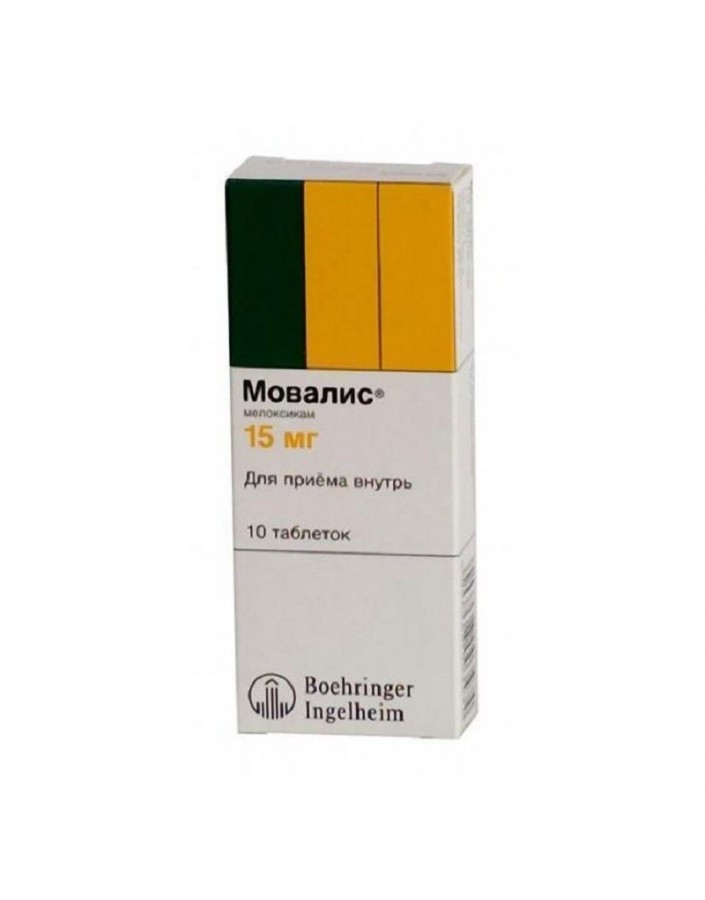



MOVALIS PILLS 15MG - 10TABS

Security policy (edit with Customer reassurance module)

Delivery policy (edit with Customer reassurance module)

Return policy (edit with Customer reassurance module)
Pills: 1 pill contains meloxicam 7.5 or 15 mg;
Excipients: sodium citrate; lactose; MCC; polyvidone; colloidal anhydride silica; crospolyvidone; Magnesium stearate;
in a blister of 10 pcs., in a cardboard bundle of 1 or 2 blisters.
Solution for i / m administration transparent, yellowish-greenish color.
1 ml of solution contains meloxicam 10 mg (1 ampoule - 15 mg);
Excipients: N-methyl-D-glucamine, glucofurol, pluronic F68, sodium chloride, Glycine, sodium hydroxide;
in 1.5 ml ampoules, in a blister pack of 3 or 5 ampoules, in a carton pack 1 pack.
tab. 7.5 mg, 15 mg: - P №012978/01, 07.06.04
rr for i / m enter. - №014482 / 01-2002, 23.10.02
NSAIDs. It belongs to the class of oxycams, is a derivative of enolic acid. It has anti-inflammatory, analgesic and antipyretic effects. The mechanism of action is associated with a decrease in the biosynthesis of prostaglandins as a result of the inhibition of the enzymatic activity of COX. At the same time, Movalis has a more active effect on COX-2, which participates in the synthesis of prostaglandins in the inflammatory focus, which reduces the risk of side effects on the upper gastrointestinal tract and slightly affects COX-1.
At the same time, meloxicam does not affect the synthesis of proteoglycan by articular cartilage chondrocytes,does not affect the development of spontaneous arthrosis in rats and mice, which indicates its chondroneutrality.
Symptomatic treatment:
- rheumatoid arthritis;
- osteoarthritis;
- ankylosing spondylitis.
- peptic ulcer of the stomach and duodenum in the acute phase;
- severe liver dysfunction;
- renal failure (without hemodialysis);
- pregnancy;
- lactation (breastfeeding);
- children's and teenage age up to 15 years;
- Hypersensitivity to meloxicam and other NSAIDs (including salicylates).
- Movalis for i / m injections should not be prescribed to patients receiving anticoagulants, given the possible risk of developing intramuscular hematoma;
- Movalis is not prescribed to patients in whom, in connection with the prescription of Acetylsalicylic acid or other NSAIDs, attacks of bronchial asthma, nasal mucous membrane polyps, angioedema, urticaria were observed.
The drug is prescribed for adults.
Movalis can be used in the / m only in the first few days of treatment. For subsequent therapy should be prescribed dosage forms of the drug for oral administration (tablets).
In rheumatoid arthritis and ankylosing spondylitis the drug is prescribed at 15 mg / day, when a positive therapeutic effect is achieved, the dose can be reduced to 7.5 mg / day.
With osteoarthritis daily dose is 7.5-15 mg / day.
The maximum daily dose is 15 mg.
Inside Individuals with an increased risk of side effects should begin treatment with a dose of 7.5 mg / day.
Patients with severe renal failure on hemodialysis the drug is prescribed in a daily dose of 7.5 mg.
Have patients with moderate renal failure (CC more than 25 ml / min) dose reduction is not required.
Tablets should be taken with food, washed down with water or another drink.
Solution Movalis should be injected deep into the / m.
Gastrointestinal: > 1% - dyspepsia, nausea, vomiting, abdominal pain, constipation, flatulence, diarrhea; 0.1-1% - transient changes in indicators of liver function (including increased levels of transaminases or bilirubin), belching, esophagitis, ulcerative lesions of the gastrointestinal tract, latent or macroscopically visible Gastrointestinal bleeding; 1% - anemia; 0.1-1% - change in hemogram, incl. change in the number of individual types of leukocytes, leukopenia, thrombocytopenia.
Dermatologic: > 1% - itching, rash; 0.1-1% - stomatitis, urticaria; Allergic reactions: in some cases - bullous reactions, erythema multiforme, Stevens-Johnson syndrome, toxic epidermal necrolysis.
Respiratory: 1% - headache; 0.1-1% - dizziness, tinnitus, drowsiness; 1% - swelling; 0.1-1% - increased blood pressure, palpitations, hot flashes.
Urogenital: 0.1-1% - change in renal function (increased creatinine and / or urea in the blood); less than 0.1% - acute renal failure; in some cases - interstitial nephritis, glomerulonephritis, renal medullary necrosis, nephrotic syndrome.
Special senses:
Movalis